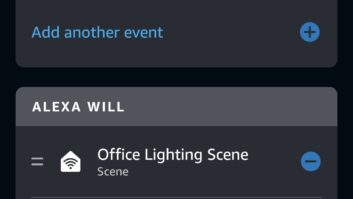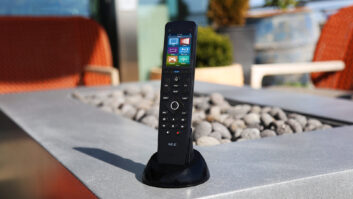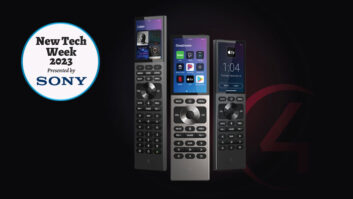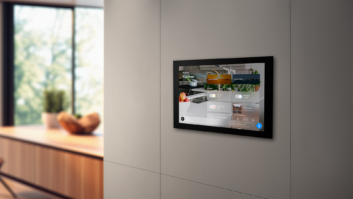“Alexa.” It’s a household name that’s become a powerful gateway to home automation, thanks to integration with Amazon’s line of Echo voice control speakers. Consumer Intelligence Research Partners estimates that U.S. consumers have bought more than 5.1 million Amazon Echo smart speakers since the company entered the market two years ago. At ProAudio Georgia, a residential and commercial integration specialist serving the Atlanta area, the technology has meant a new service offering.
“Consumers want to be on the cutting-edge, and if they’re already considering voice control due to the popularity of the Amazon Echo, then it makes sense to add it as part of your services. But the Amazon interface is still developing, which can be risky for a technology integrator if you’re not well-supported and know the capabilities and limits of what it can do,” said Steven Brawner, ProAudio Georgia’s president. “That’s where leaders in home automation like RTI come in. RTI is built around supporting emerging technology and easing the complexities that come with it. It wasn’t until an RTI two-way driver was developed by Noah Harris and Terry Coupe from Coupe Automation that I realized how I could implement this technology into my installation projects and not have it negatively impact the control experience.”

Steven Brawner, ProAudio Georgia
As most integration specialists know by now, Alexa can perform “skills,” which are voice-driven capabilities that are based off key phrases given to the system. While talking to the speaker can feel unnatural to some, simple saying “Good morning,” triggers the Amazon Echo to command RTI’s control processors to roll out a sequence of events set to that phrase. It might turn on the lights in the bedroom and bathroom, open the shades, play a pre-selected playlist or radio station, or turn the TV to a favorite morning talk show while setting the volume to an optimal listening level. Or the phrase “good night” might shut down the house for the evening, locking the doors, closing the shades, setting the security system, and turning off the lights.
Even with all the intelligence behind Alexa, when it comes to home automation, Brawner points to RTI’s leadership in integrating and smoothing out the wrinkles of emerging technology through the company’s expansive library of two-way drivers. With these drivers, integrators can knock down the hurdles of adding new products entering the market, easily customizing the technology so the experience is gratifying and natural for every user. Using RTI’s Integration Designer programming software and the Alexa two-way driver, integrators can edit and add key phrases that fit how the client wants to interface with their voice control speaker.
“It might seem surprising, but the phrase ‘Good morning’ isn’t the right phrase for every client,” Brawner said. “To some, it’s confusing, and that’s OK because I can modify it through Integration Designer to be more natural for them. And the beauty of RTI’s programming software is its simplicity and customization. To make a change, it only takes few minutes from when I turn on the computer and input the line change in the project file, to when the driver updates on the client end. I can change the key phrase to ‘Music on’ or ‘Sweet dreams, I love you, good night, don’t let the bedbugs bite’ to shut down. With RTI, you can have it say and do anything. And then it responds, ‘Thank you, have a great day,’ or whatever the client wants programmed. I love that, for the first time, technology is positively reinforcing their experience. They know it’s working.”
Brawner believes that he is in the business of making our clients comfortable with technology, and part of that experience is customizing how his clients want to interact with their technology so it feels intuitive, natural, and isn’t frustrating. “It’s all about the experience and you have to deliver on that,” he said. “There’s no going back to the client and saying, ‘OK, your new system is installed and here’s how you have to use it. Exactly like this.’ Instead, just like everything I’m able to tie into and drive with RTI’s control platform, I tell the client, ‘Now, tell me if this works for you, and whatever doesn’t work, we’ll modify it.’”
That synergy between RTI and other technology has been critical to paving the way for integrators looking to make the control experience more fluid and second nature no matter what the customer is trying to operate. Because of RTI’s open platform, it’s allowed all the latest IoT innovations to be incorporated into one user interface and seamlessly play together. For Brawner, the eye-opening moment came when he was able to quickly and easily expand a client’s Lutron lighting system within the Alexa driver.
“Instead of having to spend 45 minutes programming and crossing my fingers in hopes that it was going to work, I added two lines to the driver — the name of the zone and the name of the light — and in a matter of minutes, the client had another room within their Lutron system that could be voice-controlled from their Amazon Echo speaker,” Brawner said. “It makes the complicated easy and the easy easier, and that translates into giving clients the exact experience they want.”
Brawner says his company is implementing voice control on almost all of its recent home automation projects. And as voice control continues to advance over the next year and become more seamless, he expects his business will only grow. He anticipates the Alexa voice commands becoming even more conversationally intelligent, allowing users to talk to the Echo as they would naturally talk to a person. In three years, he can see the technology interfacing outside the home.
“For example, you will be able to say, ‘Alexa, start my car,’ and because your car is parked in the garage with the garage door closed, with the power of RTI’s home automation and control system sensing the garage door is closed, the system knows it has to open the garage door and then start the car, and it’ll do all that,” said Brawner. “In five or 10 years, I see the technology looking at your lifestyle, where it adjusts by where you are, what you’re doing, and how your day is going. Right now, we can program in sequencing controlled by timers, but imagine if sensors around your home and on your car, for example, could see that you’re 15 minutes from home. It would turn off all your lights and turns on the alarm, and vice versa when you’re on your way home. It’s an exciting prospect.”







